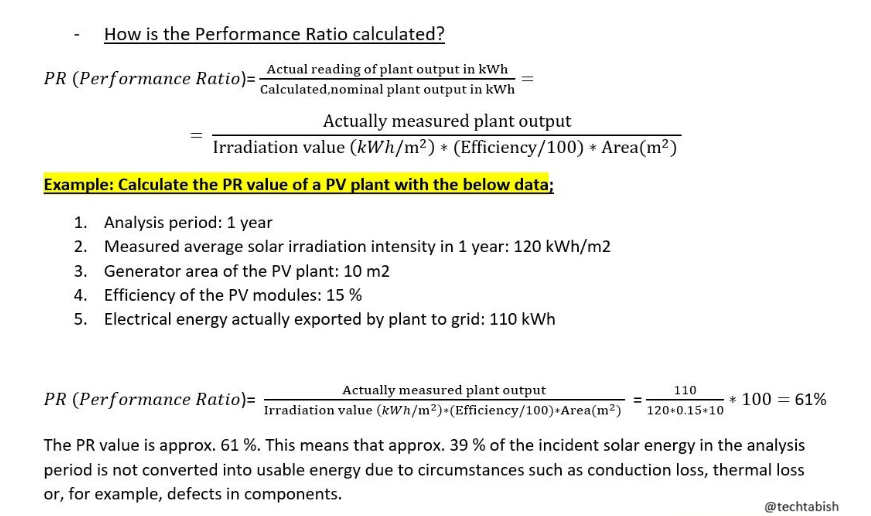This is very critical to know the performance of Big Plant about the energy generation and the total generation capacity
As you study more about it, you want to know technical parameters to analyze the overall data, one of the term coming is Performance Ratio (PR) , this is very critical to know about the efficiently of photovoltaic plant (PV).
Table of Contents
In this post I will explain you to understand about the PR, and also we will calculate it:-
What is Performance Ratio of Solar power Plant?
PR is the benchmark of the actual output energy of solar power plant to its theoretical maximum output energy in the ideal condition. This is examine in the percentage, which we can understand that how much efficiency we are getting to the usable power. This is also depend upon the pv module, orientation, installation etc.
What does the Performance Ratio says you?
PR is an important parameter, which directly impact your investment, so after installation we have to know all the details with proper calculations and data, High PR indicate that the plant is healthy and the production of energy is maximum, so high PR means you ROI will get in proper deadline. Although if your plant get less PR that means it will effect your ROI, with knowing PR your can easily identify problems and get the right solution to maintain its PR.
Understanding how the Performance Ratio is important for several other reasons:-
- Financial analysis : As we know for any projects the client require PR to address its profitability and viability, also in Capex model this is very important. In the government projects this is mandatory to have PR, itself in the tender document we can see it, so this play crucial role in the investment.
- Maintenance and troubleshooting: With the decrease in the percentage of PR itself indicate to have some Maintenance, so it can maintain its efficiency and obtain maximum output.
- Benchmarking: PR is Benchmark for the solar power plant, which understand the operator that their system is running healthy and smooth.
- Comparison tool: This is useful for the comparison to other plant or same plant.
How to calculate Performance Ratio
PR is calculated using the following formula:
PR = Actual Energy Output (kWh) / Theoretical Energy Output (kWh)
Let’s check in detail:
- Actual energy output (kWh): The Actual amount of electricity generated by the plant in a specific period of time, in month or in year. You can get data by your data logger device connected in your inverter.
- Theoretical Energy Output (kWh): This Energy is the ideal condition where there is no loss in plant.
Theoretical Energy Output (kWh) = Solar irradiation (kWh/m2) x Total panel Area (m2) x Module efficiency
- Solar irradiation (kWh/m2) : The amount of solar energy per unit area striking on the top surface at a particular angle is called irradiance which is measured in watts per square metre, W/m2, or kilowatts per square metre, kW/m2 in which 1000 watts equals 1.0 kilowatts, this data we get from the software PV Syst (Designing software), or can get from internet.
- Area of Panel (m2) : This is the total surface area covered by the panel.
- Module Efficiency : This depends upon the types of solar panel, either Monocrystalline or Poly crystalline, also different brand have different efficiency, so this also plays cruitial role in system designing.
A Solar plant is said to be working more efficiently when it achieve Performance Ratio nearly upto100 %. However a value of 100 % cannot be achieved practically because there is many losses (thermal loss from heating of the PV module). A good Plant performance can achieve a maximum PR of 80%.

Factor affecting the Performance Ratio
There is several factors affecting the PR of a solar plant: –
- Temperature : – With the increase in temperature the efficiency of the panel gets decrease.
- Shading :- This cause by the Building, Plants and other obstructions cause by shade and it reduce energy output.
- Dirt & debris : When the dirt and dust or snow get accumulate on the panel.
- System loss : – Wiring loss, inverter loss and other inefficiencies can impact PR.
